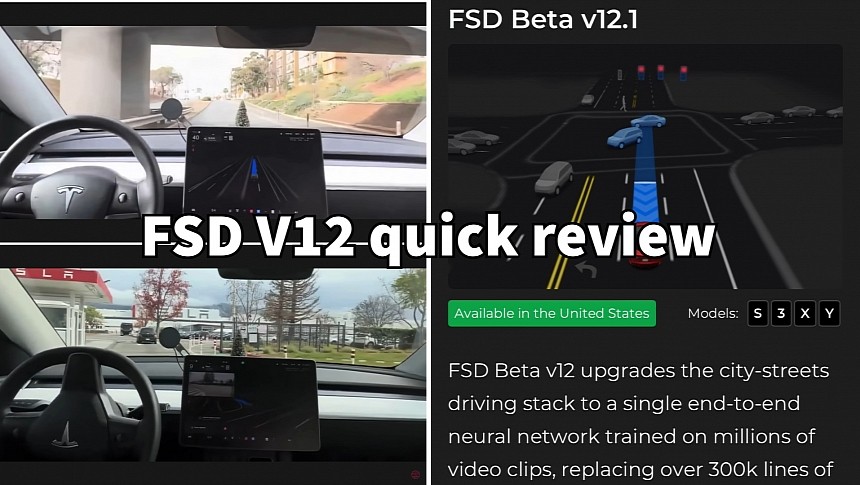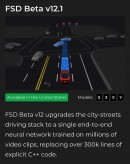Tesla rolled out FSD Beta V12.1 to Wave1 testers on December 28, and soon after that, we saw the first video showing Tesla's end-to-end AI self-driving software in action. We now have a more accurate opinion on the new FSD Beta software from a tester who used it for more than 500 miles.
If you're wondering why the hype surrounding the FSD Beta V12, it's because this marks the moment Tesla's self-driving software becomes end-to-end AI. This means that everything, from image capturing and processing to driving decisions and controls applied, is controlled by neural networks. No programmer is required to write code to tell FSD what to do when a specific event occurs. Instead, the software can learn from the driving videos it chews and later from actual driving, similar to how humans do.
As you can imagine, this is big, as it will allow FSD software to not only learn but also improve its abilities without human intervention. It's a long way from the moments when programmers created instructions after labeling millions of hours of driving videos. Everyone was eagerly awaiting the FSD V12, the first product that would benefit from the implementation of end-to-end neural networks. However, the first impressions were mixed despite obvious improvements.
A video shared online by one of Tesla's employees soon after FSD Beta V12.1 rolled out to Wave1 testers showed that the FSD software has become smoother and more human-like in maneuvering intricate scenarios. It wasn't flawless, though, as the software still had difficulties with speed bumps and certain driving situations. Still, given that this is an early build, I expect it to improve dramatically as it drives more.
That was a first impression video recorded right after installing the update, so it might not have been very relevant. Now, another Wave1 tester shared his detailed review on social media after test-driving FSD Beta V12 for more than 500 miles (800 km). As expected, there were positive surprises, as well as areas that need improvement. Tony Tong, who shared his findings, also happens to be working on artificial intelligence, which gives him a better understanding of what was happening.
Tony explains that FSD V12.1 feels more natural than V11 simply because it doesn't have the same "mechanistic nature of the C++ code in control decisions." This smoothness was also evident from the previous driving video, and now we know why. The FSD V12.1 also aligns itself smoothly with the surrounding traffic flow. Unlike previous versions, it doesn't change its "mind" in the middle of a lane change. This will hopefully eliminate the frequent lane changes that annoyed people in the past.
What surprised Tony the most while driving on a highway was the way FSD would handle driving in the fast lane when slower cars are in the right lane. Specifically, when a faster vehicle approaches from behind, the software signals and safely switches to the slower lane, allowing the car to pass. It then switches back to the fast lane and stays there if there's no other car coming from behind.
Tony also emphasized the progress FSD V12.1 made with neighborhood unmarked roads, something he called "laneless roads." While previous FSD Beta versions struggled to maintain the car on the right side, treating the road as a single wide lane, V12.1 nails it. Talking about speed bumps, the tester noted that the software reduces the speed very smoothly to 10 mph (16 kph) before crossing them. This must be a last-minute improvement because the earlier video showed a different situation.
The FSD Beta V12 still needs improvements despite these pleasant surprises. Most notably, the software spends too much time at Stop signs, while speed signs are sometimes a hit-and-miss. The main take from this review is that Tesla basically wasted time and effort trying to refine the C++ code in previous versions. Tony is confident that FSD V12 will solve many difficulties by just mimicking humans. It just needs more data and more training.
As you can imagine, this is big, as it will allow FSD software to not only learn but also improve its abilities without human intervention. It's a long way from the moments when programmers created instructions after labeling millions of hours of driving videos. Everyone was eagerly awaiting the FSD V12, the first product that would benefit from the implementation of end-to-end neural networks. However, the first impressions were mixed despite obvious improvements.
A video shared online by one of Tesla's employees soon after FSD Beta V12.1 rolled out to Wave1 testers showed that the FSD software has become smoother and more human-like in maneuvering intricate scenarios. It wasn't flawless, though, as the software still had difficulties with speed bumps and certain driving situations. Still, given that this is an early build, I expect it to improve dramatically as it drives more.
That was a first impression video recorded right after installing the update, so it might not have been very relevant. Now, another Wave1 tester shared his detailed review on social media after test-driving FSD Beta V12 for more than 500 miles (800 km). As expected, there were positive surprises, as well as areas that need improvement. Tony Tong, who shared his findings, also happens to be working on artificial intelligence, which gives him a better understanding of what was happening.
Tony explains that FSD V12.1 feels more natural than V11 simply because it doesn't have the same "mechanistic nature of the C++ code in control decisions." This smoothness was also evident from the previous driving video, and now we know why. The FSD V12.1 also aligns itself smoothly with the surrounding traffic flow. Unlike previous versions, it doesn't change its "mind" in the middle of a lane change. This will hopefully eliminate the frequent lane changes that annoyed people in the past.
What surprised Tony the most while driving on a highway was the way FSD would handle driving in the fast lane when slower cars are in the right lane. Specifically, when a faster vehicle approaches from behind, the software signals and safely switches to the slower lane, allowing the car to pass. It then switches back to the fast lane and stays there if there's no other car coming from behind.
Tony also emphasized the progress FSD V12.1 made with neighborhood unmarked roads, something he called "laneless roads." While previous FSD Beta versions struggled to maintain the car on the right side, treating the road as a single wide lane, V12.1 nails it. Talking about speed bumps, the tester noted that the software reduces the speed very smoothly to 10 mph (16 kph) before crossing them. This must be a last-minute improvement because the earlier video showed a different situation.
The FSD Beta V12 still needs improvements despite these pleasant surprises. Most notably, the software spends too much time at Stop signs, while speed signs are sometimes a hit-and-miss. The main take from this review is that Tesla basically wasted time and effort trying to refine the C++ code in previous versions. Tony is confident that FSD V12 will solve many difficulties by just mimicking humans. It just needs more data and more training.









